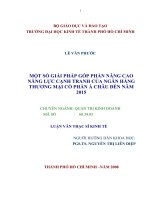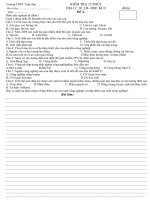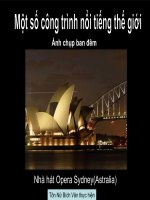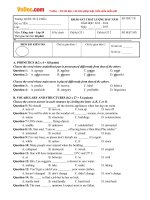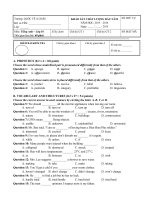A 517 a 517m 10 (2015)
Bạn đang xem bản rút gọn của tài liệu. Xem và tải ngay bản đầy đủ của tài liệu tại đây (66.05 KB, 3 trang )
Designation: A517/A517M − 10 (Reapproved 2015)
Standard Specification for
Pressure Vessel Plates, Alloy Steel, High-Strength,
Quenched and Tempered1
This standard is issued under the fixed designation A517/A517M; the number immediately following the designation indicates the year
of original adoption or, in the case of revision, the year of last revision. A number in parentheses indicates the year of last reapproval.
A superscript epsilon (´) indicates an editorial change since the last revision or reapproval.
This standard has been approved for use by agencies of the U.S. Department of Defense.
A578/A578M Specification for Straight-Beam Ultrasonic
Examination of Rolled Steel Plates for Special Applications
1. Scope
1.1 This specification2 covers high-strength quenched and
tempered alloy steel plates intended for use in fusion welded
boilers and other pressure vessels.
3. General Requirements and Ordering Information
1.2 This specification includes a number of grades as
manufactured by different producers, but all having the same
mechanical properties and general characteristics.
3.1 Plates furnished to this material specification shall
conform to Specification A20/A20M. These requirements outline the testing and retesting methods and procedures, permitted variations in dimensions, and mass, quality and repair of
defects, marking, loading, and ordering information.
1.3 The maximum thickness of plates furnished under this
specification shall be as follows:
Grade
A, B
H, S
P
F
E, Q
Thickness
1.25 in. [32 mm]
2 in. [50 mm]
4 in. [100 mm]
2.50 in. [65 mm]
6 in. [150 mm]
3.2 In addition to the basic requirements of this
specification, certain supplementary requirements are available
when additional control, testing, or examination is required to
meet end use requirements.
1.4 The values stated in either inch-pound units or SI units
are to be regarded separately as standard. Within the text, the
SI units are shown in brackets. The values stated in each
system are not exact equivalents; therefore, each system is to
be used independently of the other without combining values in
any way.
3.3 If the requirements of this specification are in conflict
with the requirements of Specification A20/A20M, the requirements of this specification shall prevail.
4. Manufacture
4.1 Steelmaking Practice—The steel shall be killed and
shall conform to the fine austenitic grain size requirement of
Specification A20/A20M.
2. Referenced Documents
2.1 ASTM Standards:3
A20/A20M Specification for General Requirements for Steel
Plates for Pressure Vessels
A435/A435M Specification for Straight-Beam Ultrasonic
Examination of Steel Plates
A577/A577M Specification for Ultrasonic Angle-Beam Examination of Steel Plates
5. Heat Treatment
5.1 Except as allowed by section 5.2, the plates shall be heat
treated by heating to not less than 1650°F [900°C], quenching
in water or oil and tempering at not less than 1150°F [620°C].
5.2 Plates ordered without the heat treatment specified in
section 5.1 shall be stress relieved by the manufacturer, and
subsequent heat treatment of the plates to conform to section
5.1 shall be the responsibility of the purchaser.
1
This specification is under the jurisdiction of ASTM Committee A01 on Steel,
Stainless Steel and Related Alloys and is the direct responsibility of Subcommittee
A01.11 on Steel Plates for Boilers and Pressure Vessels.
Current edition approved Sept. 1, 2015. Published September 2015. Originally
approved in 1964. Last previous edition approved in 2010 as A517/A517M – 10.
DOI: 10.1520/A0517_A0517M-10R15.
2
For ASME Boiler and Pressure Vessel Code applications, see related Specification SA-517/SA-517M in Section II of that Code.
3
For referenced ASTM standards, visit the ASTM website, www.astm.org, or
contact ASTM Customer Service at For Annual Book of ASTM
Standards volume information, refer to the standard’s Document Summary page on
the ASTM website.
6. Chemical Requirements
6.1 The steel shall conform to the chemical requirements
shown in Table 1 unless otherwise modified in accordance with
Supplementary Requirement S17, Vacuum Carbon-Deoxidized
Steel, in Specification A20/A20M for grades other than Grade
A.
Copyright © ASTM International, 100 Barr Harbor Drive, PO Box C700, West Conshohocken, PA 19428-2959. United States
1
2
0.05–0.15C
0.04–0.16
...
...
...
...
Zirconium:
Heat analysis
Product analysis
Copper:
Heat analysis
Product analysis
Columbium, max
Heat analysis
Product analysis
C
B
...
...
...
...
...
...
0.01–0.04
0.01–0.05
0.03–0.08
0.02–0.09
0.0005–0.005
0.15–0.25
0.12–0.28
0.40–0.65
0.36–0.69
...
...
0.15–0.35
0.13–0.37
0.025
0.025
0.70–1.00
0.64–1.10
0.15–0.21
0.13–0.23
Grade B
...
...
...
...
...
...
0.01–0.10
0.005–0.11
...
B
0.001–0.005
0.40–0.60
0.36–0.64
1.40–2.00
1.34–2.06
...
...
0.10–0.40
0.08–0.45
0.025
0.025
0.40–0.70
0.35–0.78
0.12–0.20
0.10–0.22
Grade E
...
...
0.15–0.50
0.12–0.53
...
...
0.10 max
0.11 max
0.03–0.08
0.02–0.09
0.0005–0.006
0.40–0.60
0.36–0.64
0.40–0.65
0.36–0.69
0.70–1.00
0.67–1.03
0.15–0.35
0.13–0.37
0.025
0.025
0.60–1.00
0.55–1.10
0.10–0.20
0.08–0.22
...
...
...
...
...
...
0.10 max
0.11 max
0.03–0.08
0.02–0.09
0.0005 min
0.20–0.30
0.17–0.33
0.40–0.65
0.36–0.69
0.30–0.70
0.27–0.73
0.15–0.35
0.13–0.37
0.025
0.025
0.95–1.30
0.87–1.41
0.12–0.21
0.10–0.23
Grade H
Composition, %
Grade F
Applied to both heat and product analyses.
May be substituted for part or all of titanium content on a one for one basis.
Zirconium may be replaced by cerium. When cerium is added, the cerium/sulfur ratio should be approximately 1.5 to 1, based on heat analysis.
...
...
Titanium:
Heat analysis
Product analysis
A
...
...
0.0025 max
Boron
Vanadium:
Heat analysis
Product analysis
0.18–0.28
0.15–0.31
0.50–0.80
0.46–0.84
Chromium:
Heat analysis
Product analysis
Molybdenum:
Heat analysis
Product analysis
...
...
0.025
Sulfur, maxA
Nickel:
Heat analysis
Product analysis
0.025
Phosphorus, maxA
0.40–0.80
0.34–0.86
0.80–1.10
0.74–1.20
Manganese:
Heat analysis
Product analysis
Silicon:
Heat analysis
Product analysis
0.15–0.21
0.13–0.23
Grade A
Carbon:
Heat analysis
Product analysis
Elements
NOTE 1—Where “ … ” appears there is no requirement.
TABLE 1 Chemical Requirements
...
...
...
...
...
...
0.10 max
0.11 max
...
...
0.001–0.005
0.45–0.60
0.41–0.64
0.85–1.20
0.79–1.26
1.20–1.50
1.15–1.55
0.20–0.35
0.18–0.37
0.025
0.025
0.45–0.70
0.40–0.78
0.12–0.21
0.10–0.23
Grade P
...
...
...
...
...
...
...
...
0.03–0.08
0.02–0.09
...
0.40–0.60
0.36–0.64
1.00–1.50
0.94–1.56
1.20–1.50
1.15–1.55
0.15–0.35
0.13–0.37
0.025
0.025
0.95–1.30
0.87–1.41
0.14–0.21
0.12–0.23
Grade Q
0.06
0.07
...
...
...
...
0.06 max
0.07 max
...
...
...
0.10–0.35
0.10–0.38
...
...
...
...
0.15–0.40
0.13–0.45
0.025
0.025
1.10–1.50
1.02–1.62
0.10–0.20
0.10–0.22
Grade S
A517/A517M − 10 (2015)
A517/A517M − 10 (2015)
TABLE 2 Tensile Requirements
Tensile strength, ksi [MPa]
Yield strength, min, ksi [MPa]
Elongation in 2 in. [50 mm], min, %A
Reduction of area, min, %:
Rectangular specimens
Round specimens
A
2.50 in. [65 mm] and Under
Over 2.50 to 6 in. [65 to 150 mm]
115–135 [795–930]
100 [690]
16
105–135 [725–930]
90 [620]
14
35
45
...
45
See Specification A20/A20M for elongation adjustment.
7.1.2.4 When the 11⁄2 in. [40 mm] wide rectangular-test
specimen is used, the elongation is measured in a 2 in. or [50
mm] gage length which includes the fracture.
7. Mechanical Requirements
7.1 Tension Tests:
7.1.1 Requirements—The plates as represented by the
tension-test specimens shall conform to the requirements given
in Table 2.
7.1.2 Test Methods:
7.1.2.1 The yield strength may be determined by the 0.2 %
offset method or by the total extension under load of 0.5 %
method.
7.1.2.2 For plates 3⁄4 in. [20 mm] and under in thickness, the
test specimen shall be the 11⁄2 in. [40 mm] wide rectangular-test
specimen.
7.1.2.3 For plates over 3⁄4 in. [20 mm], either the full
thickness rectangular-test specimen or the 1⁄2 in. [12.5 mm]
round-test specimen may be used.
7.2 Impact Properties Requirements:
7.2.1 Transverse Charpy V-notch impact test specimens
shall have a lateral expansion opposite the notch of not less
than 0.015 in. [0.38 mm].
7.2.2 The test temperature shall be agreed upon between the
manufacturer and the purchaser, but shall not be higher than
32°F [0°C].
8. Keywords
8.1 alloy steel; boilers; high-strength; impact tested; plates;
pressure vessels; quenched; tempered
SUPPLEMENTARY REQUIREMENTS
Supplementary requirements shall not apply unless specified in the order.
A list of standardized supplementary requirements for use at the option of the purchaser are included
in Specification A20/A20M. Several of those considered suitable for use with this specification are
listed by title. Other tests may be performed by agreement between the supplier and the purchaser.
S1. Vacuum Treatment,
S2. Product Analysis,
S3. Simulated Post-Weld Heat Treatment of Mechanical
Test Coupons,
S5. Charpy V-Notch Impact Test,
S6. Drop Weight Test (for Material 0.625 in. [16 mm] and
over in Thickness),
S7. High-Temperature Tension Test,
S8. Ultrasonic Examination in accordance with Specification A435/A435M,
S9. Magnetic Particle Examination,
S11. Ultrasonic Examination in accordance with Specification A577/A577M,
S12. Ultrasonic Examination in accordance with Specification A578/A578M, and
S17. Vacuum Carbon-Deoxidized Steel.
ASTM International takes no position respecting the validity of any patent rights asserted in connection with any item mentioned
in this standard. Users of this standard are expressly advised that determination of the validity of any such patent rights, and the risk
of infringement of such rights, are entirely their own responsibility.
This standard is subject to revision at any time by the responsible technical committee and must be reviewed every five years and
if not revised, either reapproved or withdrawn. Your comments are invited either for revision of this standard or for additional standards
and should be addressed to ASTM International Headquarters. Your comments will receive careful consideration at a meeting of the
responsible technical committee, which you may attend. If you feel that your comments have not received a fair hearing you should
make your views known to the ASTM Committee on Standards, at the address shown below.
This standard is copyrighted by ASTM International, 100 Barr Harbor Drive, PO Box C700, West Conshohocken, PA 19428-2959,
United States. Individual reprints (single or multiple copies) of this standard may be obtained by contacting ASTM at the above
address or at 610-832-9585 (phone), 610-832-9555 (fax), or (e-mail); or through the ASTM website
(www.astm.org). Permission rights to photocopy the standard may also be secured from the Copyright Clearance Center, 222
Rosewood Drive, Danvers, MA 01923, Tel: (978) 646-2600; />
3
